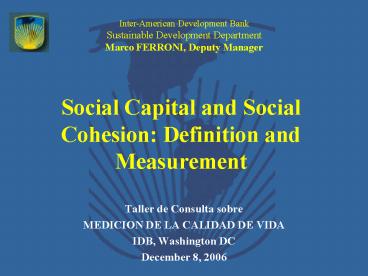Social Capital and Social Cohesion: Definition and Measurement - PowerPoint PPT Presentation
1 / 27
Title:
Social Capital and Social Cohesion: Definition and Measurement
Description:
Social Capital and Social Cohesion: Definition and Measurement ... The strategic importance ... Basic universalism. Effective and transparent targeting ... – PowerPoint PPT presentation
Number of Views:152
Avg rating:3.0/5.0
Title: Social Capital and Social Cohesion: Definition and Measurement
1
Social Capital and Social Cohesion Definition
and Measurement
Inter-American Development BankSustainable
Development Department Marco FERRONI, Deputy
Manager
- Taller de Consulta sobre
- MEDICION DE LA CALIDAD DE VIDA
- IDB, Washington DC
- December 8, 2006
2
The strategic importance of the social agenda
- The Latin American social reality is one of
persistent poverty, deep inequality, economic
polarization, and, frankly, frustration. - Improvements in living conditions worldwide,
democratization, urbanization and globalization
are - Rendering more visible the problems of exclusion
and desprotección. - Strengthening many citizens perception of being
disenfranchised and betrayed. - The economic and political costs are widely felt.
3
The relevance of the concepts of social capital
and social cohesion
- In this context, social capital and social
cohesion, as cumulative societal concepts to be
defined below, and as both means to attain
certain desired results and ends in themselves,
clearly are relevant dimensions of the standard
of living anywhere. - They are increasingly invoked as desiderata in
the evolving discussion of the social agenda and
social rights in LAC.
4
This presentation
- The purpose of this presentation is to propose a
definition specifically of the concept of social
cohesion and an approach to measuring it. We
proceed in two parts - Part I Cumulative definition and
measurement. - Part II Exploration and measurement of key
contributing dimensions Solidarity, social
protection, citizenship.
5
Part I
- Cumulative definition and measurement
6
Definition of social cohesion
- Social cohesion is the capacity for cooperation
in society based on the set of positive effects
accruing from social capital, in addition to the
sum of factors promoting equity in the
distribution of opportunities among individuals.
7
Why an index of social cohesion?
- To synthesize the state of cohesion in different
countries. - To enable a systemic view, not limited to the
individual components observed in isolation. - To permit examination of the relationships
between levels of cohesion and variables of
choice.
8
Social cohesion index
9
Issues and challenges
- Theory and architecture of index.
- Choice of variables flowing from definition.
- Data and observations.
- Soft (i.e., perception) vs. hard data.
- Standardization.
- Weights.
- Sensitivity analysis, robustness.
- Future directions.
10
Social cohesion vs. growth
- Source IDB, 2006.
11
Social cohesion vs. innovation
- Source IDB, 2006.
12
Part II
- Key contributing dimensions
- Solidarity (revenue and spending).
- Social protection (employment, social programs,
social security and pensions). - Citizenship (trust, institutions, and more).
13
The tax burden today
- Source ECLAC, 2006.
14
Social expenditure trends
Source ECLAC, 2006.
15
Solidarity The agenda ahead
- Revenue
- Improve equity and revenue-raising potential of
tax systems. - Reduce informality.
- Reduce corruption.
- Expenditure
- Basic universalism.
- Effective and transparent targeting where
appropriate. - Break the vicious cycle of
- ? Insufficient contributions ? weak institutions
? low delivery performance ? citizen
dissatisfaction.
16
Unemployment and growth
17
Social programs In health, high out-of-pocket
spending a key source of vulnerability for the
poor
- Source ECLAC, 2006.
18
Pension reform has not addressed the needs of
women, informal workers, and the poor
Source Crabbe (ed), 2006.
19
Social protection The agenda ahead
- Labor market reform.
- Technology and human capital for enhanced labor
market capability. - Pro-poor, inclusive systems of services and
protection (health, disability, unemployment, old
age). - Comprehensive advances in social assistance based
on broadly framed risk analysis, an understanding
of fuerzas potenciables at the family and
community level, and evaluation.
20
Interpersonal trust 1996-2004
21
Trends in support for democracy and satisfaction
with democracy 1996-2005
Source Latinobarometer, 1996-2005
22
Confidence in institutions 1996-2005
Source Latinobarometer, 1996-2005
23
Confidence in institutions 1996-2005
Source Latinobarometer, 1996-2005
24
Confidence in institutions 1996-2005
Source Latinobarometer, 1996-2005
25
Confidence in institutions 1996-2005
Source Latinobarometer, 1996-2005
26
Citizenship and institutions The agenda ahead
- Promote political inclusiveness through better
institutions of representation and participation. - Make legal rights accessible and effective for
all citizens. - Build open and inclusive markets that work for
the poor. - Design policies and service delivery institutions
to provide access to the poor. - Voice and the right incentives for key actors.
- Intelligent regulation.
27
Social Capital and Social Cohesion
Inter-American Development BankSustainable
Development Department
- Taller de Consulta sobre
- MEDICION DE LA CALIDAD DE VIDA
- IDB, Washington DC
- December 8, 2006































